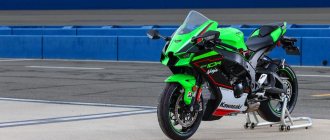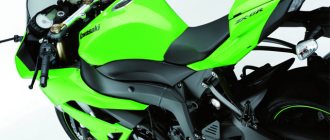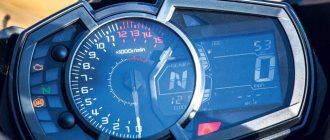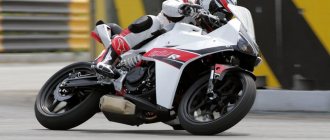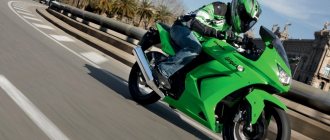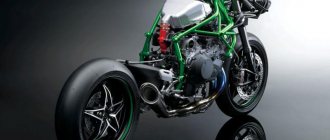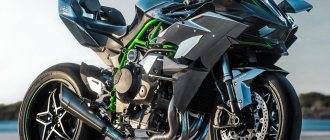| Kawasaki Z250 (2013-2014) | Kawasaki Z250 ABS (2015-2017) | Kawasaki Z250 ABS (2019+) |
Kawasaki Z250 naked model
appeared in 2013 as a budget representative of the Kawasaki Z-series road motorcycles. The model was focused primarily on the Asian market and was practically not supplied to European countries.
The Kawasaki Z250 is built on the basis of the second-generation Kawasaki Ninja 250R sports model, inheriting the frame, engine and chassis from it.
The Kawasaki Z250 was based on an in-line 2-cylinder liquid-cooled engine with a volume of 249 cm³ and producing 31 hp. power and 21 Nm of torque. Maximum performance - at 8500-11000 rpm.
The frame of the motorcycle is a tubular steel structure and the suspension is a conventional telescopic fork at the front and a progressive monoshock at the rear. Braking system - disc, front 1 disc 290 mm, rear - 1 disc 220 mm. The calipers are 2-piston.
Since 2015, based on the Kawasaki Ninja 300, a new model has been offered - the Kawasaki Z300. The Z250 version continued to be sold on the Asian market, which by this year had received minor changes - ABS as standard equipment, as well as an Assist & Slipper Clutch.
In 2022, Kawasaki introduced another restyling of the Z250 model, which is based on the latest generation sports Kawasaki Ninja 250. Major changes compared to the previous version of Z250 ABS:
- Appearance
. The model received the features of the latest generation of the flagship Z1000. - Frame
. New trellis design, similar to the H2 / H2R frame, the engine is the load-bearing element. - Pendant
. The diameter of the fork stays increases (37 → 41 mm). New rear shock absorber (travel 134 → 130 mm). - Brakes
. The diameter of the front brake disc has been increased (290 → 310 mm). - Fuel tank, weight, dimensions
. The fuel tank capacity is reduced (17 → 14 l), the model becomes shorter (in overall length and wheelbase) and taller (in overall height and seat height), the curb weight is reduced (170 → 164 kg).
The main competitors of the Kawasaki Z250 in the class:
- Suzuki GSR250 (GW250)
- Honda VTR 250
Brief history of the model
- 2013 - start of production and sales of the model.
Model
: Kawasaki Z250 (Asia).
Factory designation
: ER250CDF, ER250CDS.
- 2014 - no significant changes.
Model
: Kawasaki Z250 (Asia).
Factory designation
: ER250CEF.
- 2015 - restyling of the model. The motorcycle changes its name to Kawasaki Z250 ABS, getting ABS as standard (optional in some countries), slipper clutch and Assist & Slipper Clutch.
Model
: Kawasaki Z250 ABS (Asia).
Factory designation
: ER250DFF.
- 2016 - no significant changes.
Model
: Kawasaki Z250 ABS (Asia).
Factory designation
: ER250DGF.
- 2017 - no significant changes.
Model
: Kawasaki Z250 ABS (Asia).
Factory designation
: ER250DHF.
- 2018 - model not produced.
- 2019 - restyling of the model.
Model
: Kawasaki Z250 ABS (Asia).
Factory designation
: ER250EKF.
- 2020 - no significant changes.
Model
: Kawasaki Z250 ABS (Asia).
Factory designation
: ER250ELF.
- 2021 - no significant changes.
Model
: Kawasaki Z250 ABS (Asia).
Factory designation
: ER250EMFNN.
- 2022 - no significant changes.
Model
: Kawasaki Z250 ABS (Asia).
Factory designation
: ER250ENFNN.
Motorcycle Kawasaki Z 250 2022 review
The description of the Kawasaki Z 250 2022 motorcycle is in the queue for publication of the article. Announcement: Today, for almost every new motorcycle that comes into being, marketers strive to carve out their own niche. This one is a road sport, this one is a recreational enduro. But what class should we include a motorcycle that has a little bit of everything? A good bike should have a reliable engine, comfortable ergonomics and simple controls...
The Kawasaki Z 250 is a fairly popular motorcycle in Russia equipped with a low-power 23 hp engine. Despite the fact that good models of motorcycles have a very respectable price, and the season for their use is relatively short, the motorcycle market is developing rapidly. And if you believe the words of dealers, then some models of recently released motorcycles are selling like hot cakes at the beginning of the season, and the models brought to Russia are clearly not enough to fully satisfy consumer demand.
A motorcycle has long ceased to be an alternative to a car, and the times when this equipment was bought only because there was not enough money for a full-fledged car are forgotten. Nowadays, two-wheelers can be called technological marvels in many cases, and their cost can be compared with that of prestigious cars.
Many people have started buying motorcycles for hobby purposes as riding or even collecting them has become a good pastime for many people. Many motorcycles, for example the Kawasaki Z 250, whose technical characteristics make it possible to call the model a prestigious brand, are in demand among both beginners and experienced motorcyclists.
Motorcycles with an engine capacity of 248 cc / 15.2 cu-in. see, appeared as a result of long work of inventors who sought to create a model that was not inferior in characteristics to other versions of the motorcycle. In some cases, these models are not only not inferior, but also ahead of other motorcycles, as they have minimal fuel consumption and other excellent parameters.
The Kawasaki Z 250 belongs to a common class of motorcycles with an engine capacity of 125 to 250 kb. cmAs a rule, these are light and relatively low-power motorcycles. Here you will get flexible control, easy steering and low weight of the motorcycle. Therefore, such motorcycles are suitable for almost every beginner, regardless of their characteristics. The exception is motorcycles with two-stroke engines of the “sport” and “cross” classes, since bikes of this class are distinguished by more power and an extremely sharp response to the throttle, which also does not make them obedient to control.
Go to the entire range of Kawasaki motorcycles, on this page you can find Kawasaki Z 250 motorcycles from other years of production and information about them
Specifications
Technical characteristics of Kawasaki Z250 and Kawasaki Z250 ABS:
| Model | Kawasaki Z250/Z250 ABS |
| Motorcycle type | naked |
| Year of issue | 2013-2017, 2019+ |
| Frame | steel diagonal steel tubular - Z250 (2019+) |
| engine's type | 2-cylinder, 4-stroke, in-line |
| Working volume | 249 cm³ |
| Bore/Stroke | 62.0 x 41.2 mm |
| Compression ratio | 11.3:1 11.6:1 — Z250 (2019+) |
| Cooling | liquid |
| Number of valves per cylinder | DOHC, 4 valves per cylinder |
| Fuel supply system | Injector with dual throttle valves |
| Ignition type | transistor |
| Maximum power | 31.0 hp (23.0 kW) at 11000 rpm 37.0 hp (27.0 kW) at 12500 rpm - Z250 (2019+) |
| Maximum torque | 21.0 Nm (2.1 kg*m) at 8500 rpm 23.0 Nm (2.4 kg*m) at 10500 rpm - Z250 (2019+) |
| Clutch | Wet Multi-Disc, Cable Driven Assist & Slipper Clutch – Z250 (2015+) |
| Transmission | 6-speed |
| type of drive | chain |
| Front tire size | 110/70-17M/C (54H) |
| Rear tire size | 140/70-17M/C (66H) |
| Front brakes | 1 disc, 290 mm, 2-piston caliper - (Z250 ABS - ABS) 1 disc, 310 mm, 2-piston caliper (ABS) - Z250 (2019+) |
| Rear brakes | 1 disc, 220 mm, 2-piston caliper - (Z250 ABS - ABS) |
| Front suspension | 37mm telescopic fork (non-adjustable), 120mm travel 41mm telescopic fork (non-adjustable), 120mm travel - Z250 (2019+) |
| Rear suspension | Uni-Trak swingarm with monoshock (5-step preload adjustable), 134 mm travel Uni-Trak swingarm with monoshock (5-step preload adjustable), 130 mm travel - Z250 (2019+) |
| Motorcycle length | 2015 mm 1990 mm - Z250 (2019+) |
| Motorcycle width | 750 mm 800 mm – Z250 (2019+) |
| Motorcycle height | 1025 mm 1060 mm – Z250 (2019+) |
| Wheelbase | 1410 mm 1370 mm – Z250 (2019+) |
| Seat height | 785 mm 795 mm - Z250 (2019+) |
| Minimum ground clearance | 145 mm |
| Acceleration 0-100 km/h (0-60 mph) | 7.7 sec. |
| Maximum speed | 155 km/h |
| Gas tank capacity | 17.0 L 14.0 L - Z250 (2019+) |
| Motorcycle weight (curb) | 168 kg – Z250 170 kg – Z250 ABS 164 kg - Z250 (2019+) |
Driving performance
The maximum speed stated in the documentation is 125 km/h. Users note that with appropriate skills, the motorcycle can reach speeds of up to 100 km/h off-road. Comfortable cruiser - 80 km.
Fuel consumption
Consumption in the urban cycle, according to user estimates, is 4.5 liters. per 100 km .
The final numbers depend on the quality of the road. According to average estimates, at one gas station - 160–170 km . (tank - 7.5 l ).
Acceleration to hundreds
Acceleration to 100 km/h - 8 seconds .
Up to 80 km/h confidently, above - extremely reluctantly. Measured via GPS.
Reviews
Screenshot No. 2. Reviews from Kawasaki z1000 owners
Screenshot No. 3. Reviews from Kawasaki z1000 owners
Victor, 43 years old
An excellent motorcycle for city riding, it accelerates very quickly to incredible speeds. The weight is quite large - 220 kg, but it is easy to drive. The main problem is insufficient wind protection. At high speeds it blows away a lot, so the glass has to be replaced.
The gears are quite short, but this does not interfere much with the ride. The instrument panel is digital and can be a little difficult to understand.
Read other motorcycle reviews Full review of the Honda Africa Twin motorcycle
Kawasaki Z250 – TEST
2013 onwards, 249 cm3, 32 l. s., 168 kg,
160 km/h, 272,700 rub.
text: Anton Vlasov photo: Alexander Barkalov and Nikita Kolobanov
In the photo: Anton Vlasov
"It couldn't help but happen - it was only a matter of time before the Z250 came out ! Five years after the debut of the ultra-popular 250 cc sports bike Kawasaki Ninja 250R of the fourth generation , the Japanese concern finally decided to introduce a naked version of the motorcycle, which was doomed to success even before launching into mass production ... But the Z250 “road bike” is sold only in Asian countries ( and even then not in all): the model is not presented either in Europe or North America! From 2014, the motorcycle will be available on the Russian market.
In general, the market for 250 cc naked bikes is still Terra Incognita, perfectly developed only in Asia, where there are more different models of this class than there are types of insects. Europeans have not yet tried the dishes from the “children’s menu”, and therefore the list of road motorcycles in the “250 cm3” segment available in the Old World is not so large. However, there are also “stars” here that are traditionally in high demand (for example, Kawasaki Ninja 250R, Honda CBR250R and KTM Duke 200), and there are “dark horses” that have not yet received much recognition, but have good potential (Suzuki Inazuma 250, Benelli BN302...). For reasons unknown to anyone, the naked Kawasaki Z250, a priori doomed to success, never made it to this celebration of life, but remained exclusively an Asian exotic. The Russian representative office of Kawasaki was more far-sighted than the European office, and therefore this season the 250 cc “road car” will appear in the showrooms of branded dealers in our country. The motorcycle is built on the basis of the super popular Ninja 250R, which makes the Kawasaki concern a good box office all over the planet. The naked bike got almost everything from the best-selling “green” brand: frame, suspension, wheels, brakes, engine... Of course, some of this was not just copied, but remade and adapted to a slightly different concept of the model, but in general there is kinship, as they say, it is obvious. The test Kawasaki Z250 was tested at the end of autumn last year, and there was very little time to get to know the motorcycle. Therefore, I don’t think that this material should be regarded as a full-fledged test - fortunately I will still have time to get to know the Japanese naked bike better. This is, rather, a first look at the new product on the Russian market and an attempt to understand how attractive this device will be for a potential buyer.
Disguise Any conversation about a naked bike sooner or later comes up with the topic of the motorcycle’s appearance. And for a 250 cc machine, this is a “sacred cow”, because a person who decides to pay far from the smallest amount for a new entry-level motorcycle wants to get the maximum for his money - including the design of the machine with at least 200 horsepower ... Just like in the animal world, where the small and weak have to mimic, either depicting an extreme degree of poisonousness or demonstrating a fake weapon of self-defense, 250 cc models are trying with all their might to resemble “adult” cars. And the Z250 has perfectly mastered the art of tactical camouflage: from ten steps this device can easily be confused with another naked Kawasaki brand - the popular Z800, the external similarity with which greatly adorns the small-capacity “road bike”. The Kawasaki Z250 is a full-fledged, full-size motorcycle that, when you sit on it, doesn’t feel like you’re riding a bike that was just snatched from a three-year-old child. The ergonomics of the Japanese naked bike are definitely designed for people of average height, who, while driving this device, will feel as if they have finally found the right shoe size. The footpegs-handlebar-seat triangle creates a comfortable and natural riding position on the Z250, which quickly brings the level of communication with the motorcycle to a personal level. To get used to the device, it took me little more than to start the engine, engage first gear, move off smoothly and drive ten meters before switching to the second stage of the gearbox.
rocket booster received exactly the same engine as the latest generation Kawasaki Ninja 250R. Over several years of production, this inline 2-cylinder 8-valve engine has proven itself well in the chassis of a 250 cc sportbike - now the turn has come to the Z250. Despite its apparent simplicity, the Kawasaki power plant is a modern and technologically advanced engine in which Japanese engineers have implemented many solutions not only to achieve decent performance, but also, of course, to reduce fuel consumption as much as possible. For example, the Z250 in-line twin uses lightweight pistons and a special anodized coating on the cylinder walls, the block of which is made of aluminum. The power system has two throttle valves for each cylinder, due to which the amount of fuel-air mixture supplied to the combustion chambers is precisely regulated, and, as a result, a more linear delivery of engine power, as well as a faster and smoother response to the movement of the throttle . Of course, it is not easy to notice the real effect of all these technologies, if only because, despite the abundance of advanced technical solutions, a miracle did not happen, and the 249 cc 32-horsepower engine did not turn into a solid rocket engine. Although one “side effect” from all these anti-friction coatings and double flaps was still discovered: the average fuel consumption during the test tests of the motorcycle was only 3.7 liters per 100 km, which, taking into account not the most gentle driving conditions on the go-kart track, as well as driving in traffic jams, very, very good! Unlike most competitors, the Kawasaki concern chose a 2-cylinder engine for its 250 cc models, and not a “single-barrel” engine, as, for example, in the KTM Duke series or the popular Honda CBR250R. The advantages of the in-line “two” are known, and all of them fully apply to the power plant of the Z250 model: “smooth” operation, modest vibrations, efficiency, as well as good performance at medium and high speeds. It is the latter that makes Kawasaki’s “road bikes” so popular: when 250 cc 1-cylinder engines are already “fading away,” the Z250 engine is just waking up!
So, for example, upon reaching 7500 rpm, the Kawasaki engine seems to get a “second wind”, and the naked bike continues its dynamic acceleration. And the motorcycle’s power plant demonstrates maximum performance at almost 11,000 rpm! Due to this peculiarity of the engine’s character, even at 100 km/h the device continues to pick up speed quite quickly - up to a maximum of 160 km/h, which is more than worthy for a 32-horsepower “road car”. In general, if you have ever had the good fortune to ride a Kawasaki Ninja 250R, which every second student in a modern city has, then a ride on a Japanese naked bike will not surprise you, because these motorcycles, as already mentioned, are almost identical in everything.
Sufficient minimum The Kawasaki naked chassis is a reasonable compromise between “urban”, let’s call them that, characteristics and an affordable price for components. A steel frame with a thick central section, a simple telescopic fork with feathers with a diameter of 37 mm and a pendulum rear suspension traditional for modern nakeds with a monoshock absorber installed in a lever system. There are almost no adjustments, the general impression of the level of suspension rigidity is sufficient for city driving. At least during several days of testing the Z250, I did not have the desire to “clamp” the fork or monoshock. According to some sources, Japanese engineers have retuned the naked bike's suspension and made it a little softer than that of the Ninja 250R, however, if this is the case, I did not notice any noticeable difference. The naked bike has two noticeable differences from its popular progenitor: firstly, a modified steering geometry and the use of a classic steering wheel instead of clip-ons, and secondly, 4 kg less weight, “resulting” after removing the plastic hood. All this makes the Z250 an excellent city motorcycle, on which you can tirelessly roll viscous kilometers of traffic jams around the wheels and, with virtually no effort, “break through” congestions of thousands of cars. Perhaps the only complaint about the motorcycle is the efficiency of the braking system, which in the Kawasaki naked version consists of a simple 2-piston caliper of unknown origin and a 290 mm petal-type disc on the front wheel, plus exactly the same caliper and a 220 mm diameter disc on the rear. Despite the fact that the Z250 is by no means a heavyweight and not a 1000-horsepower dragster that cannot be stopped without three parachutes, to dynamically slow down a naked bike you inevitably have to use two brakes at once.
And although this in itself is by no means bad and should become a habit over time... it’s not at all great that the motorcycle is not equipped with ABS, and you can’t say about the effectiveness of the entire system that it stops the device particularly quickly and predictably. Here my position remains unchanged: you can save on suspension and engine performance, but the braking system should be first-class on a motorcycle of any class - and even more so on a machine for beginners. In this sense, Kawasaki engineers should definitely analyze the experience of some competitors - for example, KTM, which installs ... radial 4-piston front calipers of the Bybre brand, owned by Brembo, on the “budget” naked bikes of the Duke family. And relatively cheap, and more than cheerful.
Hit So what are the chances of Kawasaki's naked bike to succeed on the Russian market? Considering the close relationship of the Z250 with the Ninja 250R, I don’t think that the new product will be deprived of the attention of buyers! It is this similarity that makes the naked bike an almost guaranteed hit on the market, because the already more than successful motorcycle has become even better suited for city driving, even more attractive in appearance and even, it seems, a little faster! The 250 cc Kawasaki “road bike” is like a remake of a popular and beloved film: the plot is the same, all the drama is the same, and even the actors are similar, but with the use of modern special effects, and yet a little differently... Is it possible? such a product be unpopular? /
Design Features
Quite often, motorcycle glass undergoes changes, as owners note insufficient wind protection on the original model. Below are photos of the tuning:
Option 1 of tuning the Kawasaki z1000 motorcycle
Option 2 of tuning the Kawasaki z1000 motorcycle
In addition to glass replacement, steering wheel handles and sliders are often installed, and some people install new seats.
Owner reviews indicate that Kawasaki is not subject to frequent breakdowns. If repairs are necessary, numerous manuals available on the Internet will help you cope with the situation. Repairs can be made at any motorcycle dealership.
Many people ask: how much oil should I fill in a Kawasaki z1000 2007-2009? You need to rely on the motorcycle manual, but the average amount is 3-4 liters.

